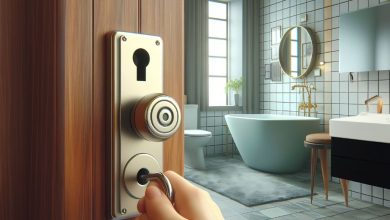How to Change a Faucet in the Bathroom: The Easy Way

Changing a faucet in the bathroom doesn’t have to be a difficult task. With a few simple tools and a little bit of patience, you can easily change a faucet in the bathroom. In this article, we will walk you through the entire process step-by-step so that you can feel confident taking on this challenge.
First, you will need to turn off the water supply to the faucet. You will likely find the shut-off valve behind the sink or beneath it. You will want to make sure that you turn the water off completely so that there is not even a drip of water coming out of the faucet when you start to work on it. Once the water is turned off, use a pair of pliers to remove the faucet’s handle gently.
Next, you will need to use an adjustable wrench to loosen and remove the nuts around the base of the faucet. Once these are loosened, you should be able to pull out both the faucet and its attached components carefully. Finally, you can put in your new faucet and securely tighten it with the adjustable wrench. Make sure you double-check to ensure that everything is secure and properly fastened.
Now that your new faucet is in place, all left is to turn on your water supply and ensure everything works correctly by running some water out of the faucet. With a few simple steps, you have successfully changed your faucet in the bathroom!
Make your bathroom look modern and updated with these fresh and stylish design ideas for new fixtures. From picking the right faucet to replacing the sink and installing a new showerhead, you can give your bathroom a dramatic makeover with just a few changes. Learn what you need to know to update and modernize your bathroom with new fixtures.
The Basics of Home Plumbing: How to Change a Faucet in the Bathroom
Changing a faucet can seem daunting, but it doesn’t have to be! With the right tools, a little knowledge, and patience, anyone can change a faucet in their bathroom.
First, turn off the water in the bathroom. This can typically be found near the main water line, where it splits into two paths; one to the kitchen and one to the bathroom. Shut off the valve, so water is no longer running to the bathroom.
Next, you will need some tools. You’ll need a screwdriver and adjustable wrench or pliers. The screwdriver removes any existing screws that may be holding the faucet in place, while the adjustable wrench or pliers are used to loosen or remove any nuts or bolts in the way.
Once you have all of your supplies and tools ready, it’s time to begin. Start by taking off any screws that are holding the old faucet in place. Then, use your adjustable wrench or pliers to loosen or remove any nuts or bolts that could be in the way. If joints or pipes have eroded over time, you may need to use some plumber’s tape.
Once everything is loosened up, it is time to install your new faucet. Place the new faucet on top of where the old one was removed and reconnect any pipes that may have been disconnected during the removal process. Use Plumber’s tape at each joint to ensure a secure fit and reduce the risk of leaks. Once everything is reconnected and secure, turn the valve on to check that there are no leaks before ultimately tightening all bolts and nuts again.
Once everything is tightened back up, and you have checked that there are no leaks, you can turn the water back on and enjoy your new faucet! With just a few simple tools and steps, anyone can easily change a faucet in their bathroom!
DIY Home Improvement: Changing a Faucet in the Bathroom
One of the most straightforward and most satisfying DIY home improvement projects is changing the bathroom faucet. By investing a small amount of money and time, you can change the look of a bathroom from dull to bright.
The first step in changing a faucet is selecting the one for your needs. There are many types of faucets available that range from traditional to modern. It would be best to consider factors such as finish, style, installation type, and cost. Make sure to take careful measurements before purchasing your faucet.
Once you have selected and purchased your new faucet, it’s time to remove the old one. Turn off the water supply by turning off the shutoff valves beneath the sink. After that, use a wrench to disconnect the supply lines from the faucet. Carefully remove the old faucet from the sink and discard it properly.
Next, you will need to prepare for installation by ensuring a secure fit for the new faucet. Please place a new rubber gasket over the mounting holes around the sink and set the new faucet over them. Secure it with mounting nuts that come with your faucet. You should also reconnect your supply lines and turn them clockwise until tight.
Finally, turn on the water supply to test for any leaks. If there are no leaks, you have completed your DIY home improvement project! Now enjoy giving your bathroom an updated look with your new faucet!
How to Repair a Leaky Faucet in the Bathroom
Leaking faucets can be a nuisance and waste water if not repaired quickly. Repairing a leaky faucet in the bathroom is a simple task that anyone can do.
The first step when repairing a leaky faucet is to turn off the water supply to the bathroom. This can be done by turning off the house’s main valve or the shutoff valve under the sink.
After the water is shut off, remove the faucet handle from the faucet body by unscrewing it. Use an adjustable wrench or pliers to help loosen the handle if necessary. Take out the screw that holds the handle in place and then gently pull apart the handle from the faucet body.
Once the handle is removed, look for any signs of corrosion or damage on the cartridge inside the valve body. Replace any parts that are cracked or corroded. After replacing all the damaged parts, re-assemble the faucet by putting the cartridge back in place and securing it with the screw.
Next, check whether or not there are seals around the valve stem and replace these if needed. Once all seals are replaced, attach the handle back onto the faucet body and secure it with a screwdriver. Ensure all connections are tight and waterproofed before turning on the water supply.
Finally, turn on the water supply to test if your repaired faucet is working correctly. If there are still leaks, try tightening all screws and joints and check for any other possible problems, such as clogs or drainage issues. With some effort, you should have your leaky faucet working correctly in no time!
The Right Tools for Changing a Faucet in the Bathroom
Changing the faucet in your bathroom can be a simple, straightforward task when you have the right tools. Before you begin the process, you must ensure you have everything required to complete the job.
The essential tool for replacing a faucet is a wrench. A basin wrench is best for this specific job, as it allows you to reach tight spots more quickly than a regular wrench. It is also important to have gloves and eye protection just in case something goes wrong.
You will also need basic supplies such as emery cloth, rubber mallet, and plumbers putty. Emery cloth is used to remove rust or corrosion from the old faucet and ensure the new one can be installed properly. The rubber mallet will help you make sure the new faucet is tightened securely, while the plumber’s putty will help create a seal with the sink when installing the faucet.
Another essential item you should have on hand is a screwdriver, which will install any mounting hardware with the new faucet. Lastly, you may also need some channel locks or adjustable pliers to help secure any nuts or bolts on the new faucet in place.
Having these items ready will help ensure you can replace your bathroom faucet without any problems. With the right tools for the job, changing a faucet in your bathroom is a task that nearly anyone can do.
Common Problems When Changing Faucets in the Bathroom
Changing faucets in the bathroom can be a difficult task for many inexperienced DIYers. Here are some common problems to look out for when attempting this project.
The first problem you may run into is an old, corroded faucet. This can make it difficult to unscrew the faucet, as the corrosion prevents you from getting enough grip or leverage. You may need a wrench or pliers to loosen the corroded nut.
Another potential issue is incorrect measurements. You will need to purchase a new faucet that will fit the space where the old one was. If you do not measure correctly, you may have to fill gaps with caulk or buy an adapter for the faucet to fit correctly.
Leaking is another common problem that occurs when changing a faucet. If the sealant and gaskets are not installed correctly, water may leak from under the faucet and onto the floor, causing damage or creating a hazardous slip-and-fall situation. Properly seal all connections with Teflon tape and caulk before connecting your new faucet.
The last issue many experiences with DIY plumbing is malfunctioning valves. If you fail to install the shut-off valves when changing a faucet correctly, it may cause pressure build-up within the pipes, which could cause them to burst, leading to flooding and water damage in your home.
When changing a faucet in your bathroom, you can avoid potential disasters and complete the project successfully by keeping these common problems in mind.
Choosing the Right Faucet for Your Bathroom
Choosing the right faucet for your bathroom can be a daunting task. There are so many styles, colors, and features that it can be hard to decide which is right for your unique needs. To help you decide, here are a few tips when selecting the right bathroom faucet:
First, consider your budget. Knowing how much money you can spend on the faucet will help narrow down the options available.
Second, select a style that complements the existing color palette in your bathroom. From traditional to more contemporary designs, there is y a match for every aesthete.
Third, think about the type of faucet you would like. Do you prefer a single lever handle or handles with separate hot and cold components? What type of finish do you want?
Fourth, consider the type of installation needed. This will dictate whether you need a professional installer or can do it yourself.
Finally, pay attention to the warranty and product reviews. This can help ensure that your new faucet will last many years.
Considering these suggestions when shopping for your next bathroom faucet, you’ll be sure to find one that fits your vision and unique needs.
Tips for Installing New Faucets in the Bathroom
Installing a new faucet in the bathroom can be a great way to update the look of the room and add a modern touch. Here are some tips for installing a new faucet in the bathroom:
- Make sure you have all the necessary tools and supplies. This includes the faucet, washers, screwdriver, plumbing tape, putty knife, plumber’s putty, and a basin wrench.
- Shut off the water supply before beginning. This is an important step that should not be overlooked. It will prevent water damage if something goes wrong during installation.
- Use a basin wrench to remove the old faucet from its mounting nuts. Be careful not to damage any of the surrounding pipes while doing so.
- Install the new faucet according to the manufacturer’s instructions. Make sure it is secure and properly mounted.
- Seal any exposed pipes with the plumber’s putty to prevent leaks.
- Connect the faucet to the water supply line using hoses and fittings provided by the manufacturer or purchased separately if needed.
- Please turn on the water supply and test the faucet to ensure it is working correctly and there are no leaks.
- Finally, install a set of decorative knobs or handles on either side of the faucet for a more polished look.
Following these steps, you can easily install a new faucet in your bathroom, transforming it into a more stylish and modern space!
Design Ideas for Updating Your Bathroom With New Fixtures
Giving your bathroom a facelift can be achieved by investing in new fixtures, such as taps, shower heads, and toilet cisterns. It’s an effective way to bring a bathroom that’s looking a little tired up to date and give it that modern look. Here are some design ideas for updating your bathroom with new fixtures:
- Swap out your current fixtures for bright, shiny chrome fittings to give the entire room a modern and stylish look. You can also choose brushed nickel for a softer look with contemporary appeal.
- If you’re after something more glamorous, opt for brass or copper fixtures with intricate designs to add an elegant touch. These fixtures will also help to create a more inviting atmosphere in your bathroom.
- If you have a garden tub in your bathroom, you can add luxury by installing an ornate showerhead above it. The effect created by the water cascading down the sides of the tub is simply stunning.
- Wall-mounted fixtures are becoming popular in modern bathrooms, as they can be easily installed without significant changes to your plumbing. Plus, they look sleek and stylish and provide a spa-like feel in the room.
- Freestanding taps are now available for the bathtub and washbasin, making it easier to enjoy a relaxing soak or wash away the day’s worries. These taps also lend a sense of sophistication to any bathroom space.
Updating your bathroom with new fixtures is an easy way to give it a makeover and bring it up to date with the latest trends and designs. With these design ideas in mind, you’ll have no problem finding the perfect combination of fixtures that fit your style and budget.
Conclusion
Changing a faucet may seem intimidating, but with a few simple steps and suitable materials, it can be easy. First, you’ll need to shut off the water supply coming into the faucet. Then, use a wrench or socket to unscrew the old faucet and remove the mounting nut with a basin wrench. Next, prepare the mounting surface for your new faucet and apply putty to the underside. Finally, install your new faucet to tighten all mounting screws and nuts securely.
In conclusion, changing a faucet in the bathroom doesn’t have to be complicated. All you need are suitable materials and some basic knowledge. Shut off the water supply, unscrew the old faucet, prepare the mounting surface for your new faucet, apply putty to the underside, and install your new faucet securely. Following these steps should result in a successful installation of your new faucet that you can be proud of!




